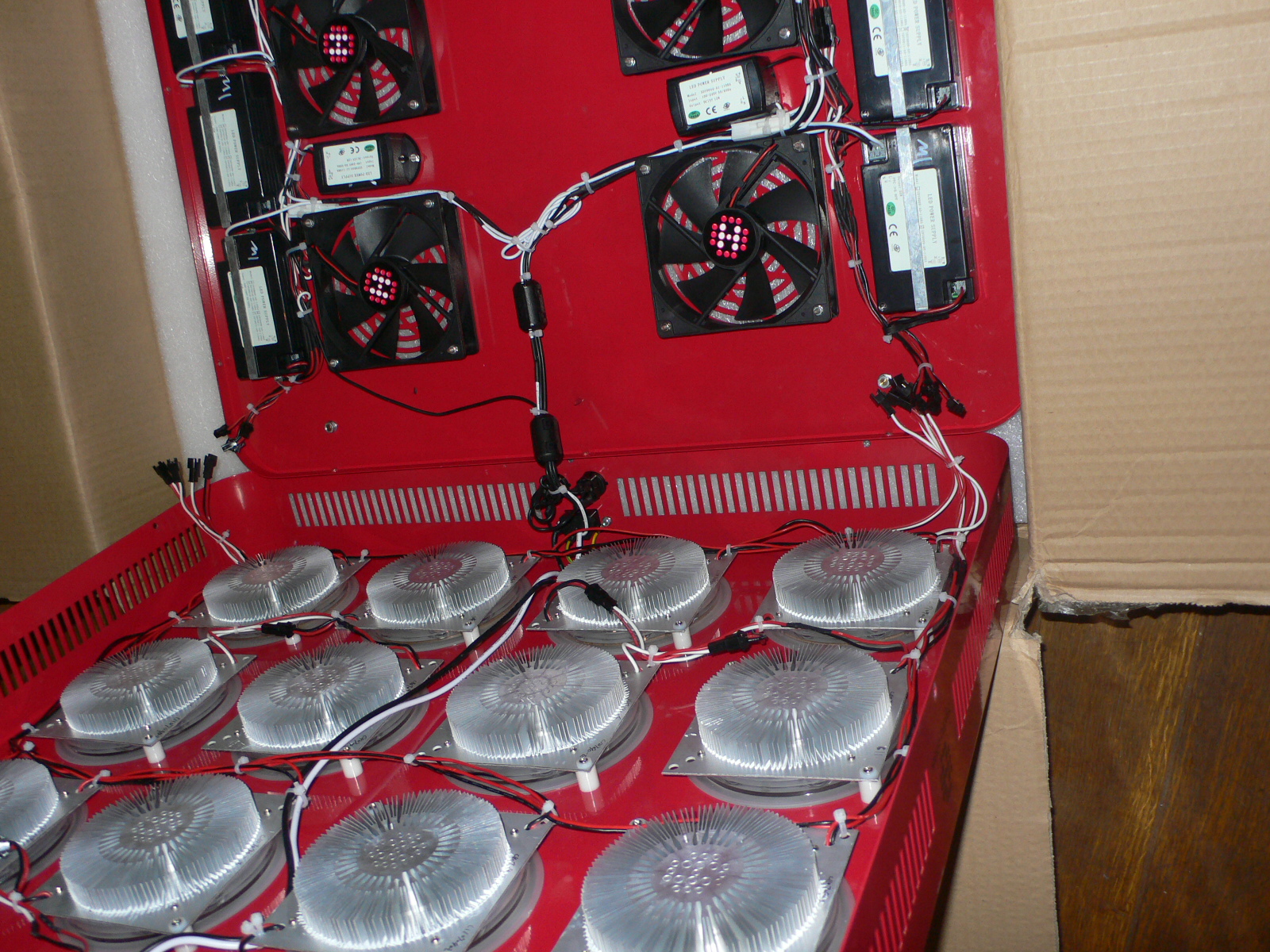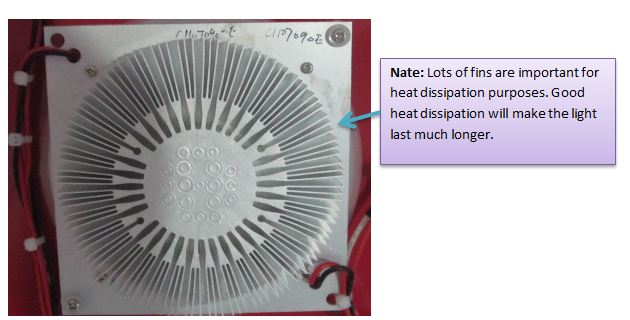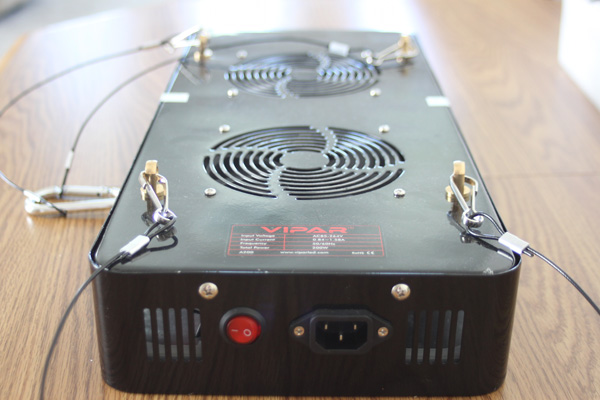Hydro Grow LED Review with Cammie Mckenzie

Hello Readers. Today we’ll be talking with Cammie Mckenzie, the president of Hydro Grow LED. First off, I have to tell you a quick story about Cammie that will help you know a bit more about the customer service you can expect from Hydro Grow LED.
Normally when I email asking for an interview, for whatever reason, it takes the company at least a couple of days to get back to me to let me know yes or no. Well, I emailed Hydro Grow LED one morning at 10:41am asking for a potential interview opportunity (keep in mind that this was my first contact with the company). At 11:21am (a mere 40 minutes later) I had received an email from an owner of the company (Cammie) telling me I could call them right now and do the interview if I was ready. Unfortunately I wasn’t ready, but hopefully this gives you a good feel for the type of service you can expect from Hydro Grow LED. The response time is absurdly fast.
Questions
Well, with that introduction in mind let’s get to the questions:
Nate: Cammie, thanks a ton for taking some of your valuable time to share more information about your lights and your company. I certainly appreciate it and I know that many of my readers do as well.
Nate: What advice can you give to those who are just getting their feet wet with LED growing technology? A lot of people want to try out LEDs but they feel overwhelmed by the amount of information out there (some of it is bad).
Cammie: The biggest piece of advice I can offer is “Do your research”. Many companies prey on customers who know little to nothing about photosynthesis or LED Grow Lights, and often mislead these customers into believing they have the best product. Those who educate themselves on photosynthesis, the emerson enhancement effect, and quantum efficiency will be able to weed through the gimmick salesman to find the products that are truly made for their gardens. Also, take nothing at face value. If a company claims their 300W can match a 1000W HPS, ask for the tests or data that proves their claim. If they can provide no such data or proof, it’s easy to determine their product ratings have no real basis. So don’t just “trust them” or “take their word for it” when they are unable to offer you proof of their claims. A legitimate company should have documentation of such things.
Nate: Currently, what’s your most popular light?
Cammie: Our 336X-PRO is our most popular light. It seems the bigger and badder we make them, the more our customers love our products. The second best seller is the 336X followed by the 189X-PRO and 189X.
Nate: Which of your lights would you recommend to those just starting out with LED grow lights? From what I gather you have three main series or generations of lights. Which group of growers (or plants) are you targeting with the Penetrator series? The Penetrator Pro series? The Penetrator X-Pro series?
Cammie: The Penetrator and Penetrator PRO lights feature core technology developed by Hydro Grow that has dominated the LED Grow Light industry for the past 2 years. These lights are designed for plants of any type as with all of our products, but were designed firstly for Cannabis. The power from our 60 degree lens allowed these lights to penetrate deeper into plant tissues and maintain intensity further down the plants, which is perfect for Cannabis. Our new Extreme LED Grow Lights (X or X-PRO) feature new Extreme Lens Technology that we developed to enhance performance and coverage. These lights are the best of the best, but are certainly not for those on a tight budget. Our Extreme LED Grow Lights are 100% our creation, whereas our Pen and Pen PRO lights were developed using pre-existing LED casings, PCB’s, etc… designed by the Chinese. You won’t find a higher quality or higher output light than any of our Extreme models.

These lights are built to last.
Nate: If you had to name two or three specific criteria for potential customers to look at when buying an LED grow light, what would they be and why?
Cammie: Spectrum is #1, and this determines both how a plant will grow, as well as yield and growth time. An improperly tuned spectrum will reduce growth rate, reduce yield, and even cause morphological changes within your plants. We fully educate our customers on our spectrum and the changes we have made over time to achieve desired effects. Knowing about photosynthesis and the other sciences mentioned above will help you determine which spectral outputs you should be looking for in a LED Grow Light, and which are wasted.
#2 is Warranty, because there are a lot of parts that go into LED Grow Lights and anything electrical is going to fail eventually. Watch out for companies offering only a 1 year warranty on their products, as these companies pay no attention to quality or temperature and instead sell you a light that is designed to fail within 2 years. LED Grow Lights are expensive, so make sure whoever you buy them from gives you support on the light for at least 2-3 years.
#3 is Results. If a company can’t show you proof of their claims, or that their lights are “the best” as they claim, then move on. It’s 2011 and LED Grow Lights have been out since around 2007. If a company can’t show you results this day in age, they probably haven’t even tested the lights themselves on plants. They’re just in this industry to make a quick buck off the uneducated consumer.
Nate: Some of your competitors produce one light for the germination/vegetation stage and another light for the flowering stage. Some produce one light that has certain lights for vegetation and certain lights for flowering that you can turn on and off. Do you do anything like this? Do you think it’s necessary? I guess what I’m really trying to ask is can your lights effectively grow a great plant from start to finish or are they better at certain stages of the plant’s lifecycle?
Cammie: The problem with limiting spectral outputs in any stage of growth, is that you slow the rate of photosynthesis and bring about morphological changes within the plant. Humans have been limited to HID and CFL technology for years, and due to limitations with these technologies have been given the choice of a blue-centric or red-centric spectrum. One stunts a plant causing it to grow shorter and bushier, while the other causes a lot of stretching. Plants have evolved to use both red and blue wavelengths however, in all stages of growth. Evidence of this can be seen by looking out your window and starting at the sun, which delivers the same spectrum to plants year-round. A properly tuned LED Grow Light will deliver a 100% bright spectrum, 100% of the time, and use red, green, and blue LED’s to fulfill all photosynthetic and quantum requirements. Otherwise you’re limiting how fast your plants can growth and what processes during photosynthesis they can undertake by limiting the spectral input to the plants.
Nate: I’m always curious about the heat dissipation factors of these LED lights. My understanding is that an LED grow light will last much longer if a high-quality heat sink is in place. What’s your current heat sink setup?
Cammie graciously sent the following picture:

My first impression is, “That’s a lot of fins!” Fins are a good thing and I talk more about heat sinks in general at this post called Finding a Good LED Grow Light.
Nate: Second to last question. If you had to name one or two things that really separate Hydro Grow LED lights from your competitors, what would they be?
Cammie: Hydro Grow is in the only company in the industry who develops our own products. From our heatsink design down to our new lens, or our spectrum, it was all developed in-house by our engineers and scientists. We are a technologically and scientifically backed company, which is evident when viewing our site. We don’t leave things to chance, we don’t make you take our word for it, and we prove beyond a doubt that we have the best LED Grow Lights in the world. We are also growers, so every change we make to our design gets thoroughly tested before its release.
The main thing that separates us from everyone else is our knowledge of LED’s and plants. You can ask me any question and I will have the answer for you in regards to plants or LED Grow Lights. When calling our competitors you get a lot of BS and excuses, but with Hydro Grow you get real, tangible answers.
Nate: Anything else you would like to share with our readers about your LED grow lights or company?
Cammie: We’re now offering a 100% money-back guarantee on all of our new Extreme LED Grow Lights, as we have the utmost confidence you’ll want more of them after trying them for yourselves. We’ll also have full PAR data published to our site within a matter of weeks, that no other company in the world has. We lead the world in both development and data for LED Grow Lights.
Note to Readers: Normally I have more questions about spectral wave-lengths, actual wattage draw, beam angle, trial period, and warranties but Hydro Grow LED has all of this information already posted conveniently on their website. Pretty impressive stuff.
Conclusion
Thanks a ton for working with me on this interview Cammie. Cammie has done a lot to push the LED grow light evolution faster than it would otherwise be going. On behalf of me and all my readers we thank her for taking time to talk with us today.



Did you ask her about the rumors posted about her?
Hey Ozzy,
I didn’t ask her about them. There is a lot of junk out there on the Internet and it is hard to know what to believe. In fact, that’s why I decided to contact her myself. I wanted to form my own opinion based on my own interactions with her.
I find that when I treat people respectfully, they treat me respectfully in return (Cammie was no exception to this rule).
You honestly never know. Maybe one of her competitors simply started a slander-campaign against her. The business world can be tough sometimes.
Anyways, I try to keep my interviews more focused on the lights.
I have to say that you would make a killer interviewer Ozzy!
All of that being said, once I form a longer-term relationship with Cammie, I might ask her about those rumors someday (it might be good for her to clear them up). You have to build a relationship of trust first though. The people you are interviewing have to know that you aren’t out to get them, but that you are just trying to provide information to the world. All the best reporters have long-term relationships with the leaders in the industry (and Cammie is definitely one of the leaders in the LED grow light industry). The leaders trust them and that’s why they get a chance to ask them questions. If a reporter comes out slinging mud everywhere, then he or she won’t get very far in the profession (all the people with the information will simply avoid that reporter).
Does that make sense?
Thanks again for your comments.
Nate
She is a crazy lady. She resorts to name calling as soon as you disagree with her.
I have ordered several lights from this company and I have never had to speak with Cammie, because there has never been a problem…until recently…I ordered a 336x pro and it hasnt worked since day 1. I have tried to speak with her and a funny comment she made about here competitors about making excuses…..she makes every excuse in the book..she has more stories than a library. I have tried working things out with her, and her customer service is 1/2 star out of 5. its about 3wks now and I still have not been able to get my light fixed or have I been offered a new light for exchange. instead Ive been offered to send it back which would leave me with no light for another 1-3wks…dont get me wrong..if you get a light that works, then youre in the money..HG has the best lights on the market, but her customer sevice…its the worst in the Biz…Ive deal with 2 other companies in the LED biz, and what sets them apart is that there customer support and service as good as her lights….she knows her lights and has a good thing going…I hope she can get her act together on the customer service side…if you have a problem…Good Luck my fellow growers getting it resolved in a timely manner. I am still waiting for parts to arrive..and the 336x pro is not as user friendly as She claims..if you have no kind of experience in electronics..you will be lost..until she backs up her claim that a part ( if you get the correct parts) or components to be replaced come with step by step instructions like the web site claims..might as well send it back to her to be fixed. I could go on and on..she boasts a lot of claims but does not stand behind her product like she claims..I have shops all over the country and have been backing her pro lights for about a year now…I have since considered removing all of them and going with a different company…one thing she does say that holds true…do you research..there are other companies out there producing great LED lights and have excellent customer service. HG is not even BBB rated. stay tuned..she has shown hints of caring about the problem, but I am still waiting for my 2000 dollar light to be fixed..stay tuned
The same story – Cammie was gone after the payment. She has deceived us?
I take my words back ! Cammie replied that she sent my order and gave a tracking number. She did not cheat ! PARDON ME ))
Hey Za.rip and Juice,
Thanks for sharing your experiences on the site. It really helps. I honestly believe that Cammie is not out to cheat anyone. In these high-tech areas you often see new products require some time to get the details worked out. HydroGrowLED just barely released the x-lens technology with modularity. Modularity is going to be a game-changer in my opinion, but there are going to be a few kinks along the way (and it appears you guys are experiencing some of those kinks).
Juice, please keep us posted as to whether or not this problem gets resolved. Taking the time to share your experience will benefit the rest of us.
Best,
Nate
With that said….. The product she sells is pretty good. She is her company’s biggest problem. I would quit growing weed before buying a lamp from her.
Nate, you want real reviews that help folks? Here they are. Use them
The worst of the worst claim about her:
“Cammie aka LEDgirl threatened to turn my address into the authorities simply for calling her out in one of her threads on icmag”
I received my 336x 3 weeks after I placed the order with a whole row of light engines that weren’t working. Her warranty policy isn’t really “hassle free” like the website claims. She was slow at responding to my email so I called and talked to her multiple times for her to send out replacements. To say the least, it was a lot of work on my part. When I made a complaint about her slow response to warranty my light, she called me a liar and said that she never received my emails or the 2 previous calls I made. I agree with Ozzy “[Cammie] is her company’s biggest problem”.
I recently received my lamp. I’ll be honest – it is something incredible! My girls had grown under the LED 300W (LightHouse Hydro) – after I installed the 189 X-PRO, they began to bloom profusely. I am very pleased with this light, it really is another level of LED lighting =)
Thanks to Cammie.
Hey za.rip,
Thanks for commenting. I’m pretty excited about her lights as well. I’ll be getting one in the mail pretty soon. Hope to post more details on the website at a later date.
Best,
Nate
Nate you should allow people to see the links I posted. They tell a lot about this company.
BTW, my very first comment in this article was edited by Nate. I did not ask that question.
Hey Ozzy,
Sorry, I had to edit your question because it had some vulgar language. Trying to keep the site as professional as possible. Basically you asked the same question (just with some choice words).
Best,
Nate
For some reason wordpress catches any post that has multiple links in it and sends them to the spam section. I’m looking over the links you posted. I’ll post them if I think they are a good fit for the site. Some of the stuff posted on those forums is very hard to believe.
Best,
Nate
How can we use this site to sort the good LEDs from the bad ones when all the lights you review are great?
I haven’t given all the lights good reviews and I have my top three list in the recommendations section. I think that the industry leaders (ProSource, HydroGrowLED, Gotham, and Advanced LED) are all providing some good lights so that’s why they are getting good reviews. I’m currently testing a light too that I think has some potential.
Best,
Nate
How about those Magnum LED lights? No reviews on those yet? I’ve been reading some awesome stuff on those things. The penetrator x line is ahead, but can we get a review on the magnum line? Maybe the Magnum Plus?
Hey TCal,
I just finished my review of the original Magnum (it will be posted sometime next week).
I’m going to start working on my review of the Magnum Plus this week. I have a lot of questions for the company, but if they respond to me quickly then that review should be done within the next couple of weeks as well.
Thanks for stopping by! If there’s any other lights you’d like to see reviewed, let me know.
Best,
Nate
The deal with Cammie and the crap storm on the net; was all started by a crazed customer.
The customer wanted to test some lights, and they had come to a deal.
She shipped out the lights, but the customer never held his end of the deal.
Thus leaving her out a bunch of money.
So being upset she latched out and did what anyone would do.
Try and get their product back….
An then from there things started and snowballed in the forum’s.
I’ve talked with Cammie and worked with her on a small project.
She can have her moments, but everyone has those days.
We as people try to do our best to be good mentors and advisors.
If you have problems with Cammie, just relax…
Give her time, running a large business can get crazy at times.
Remember when one has a top player in the industary, your always busy.
A
Thanks for your interview which think is outstanding and fair.
Cheers Rex
Cammie is a FRAUD, who has knowingly taken money from unsatisfied customers. Why is she saying that “her company” developes all of the lights? She is barely more then a DROP SHIP company that re-sells cheap low quality products from China (just like her/his old Nissan business). @OZZY I am thinking Nate and Za.Rip are really just Cammie or another person tryin to advertise and drum up business. She should have gotten arrested and thrown in jail with her drug-dealing ex roomate!!
Hey Rated,
No need to be so harsh my friend. I simply use the Penetrator X-Pro and it works great. I have several different LED grow lights (probably more than you) and the Penetrator X-pro is very high quality compared to other lights on the market. I’m not saying its the only high quality light on the market. I think Prosource, California LightWorks, and Spectra also put out very high-quality lights. Blackhouse puts out a great light for the price (though its quality is a bit lower).
I’ve talked with Cammie personally about the accusations and I’ve talked with other people like you and Ozzy. I think it is important to hear both sides of the story before drawing conclusions. The point of this site is present users with good information. I appreciate you sharing your thoughts. I only ask that you do it in a respectful manner.
Have you used one of Cammie’s lights? Has she personally done something wrong to you? Or did you simply read a random forum post and grab your pitchfork? I know quite a few people who are happy with HGL’s lights. In fact, I haven’t run into anyone who owned the light and thought it was poor quality. I’ve only run into people who don’t own the light yet hate it (kind of weird).
Best,
Nate
Hey you – do not fool yourself. I do not have anything to do with Cammie – I’m an ordinary grower from Russia. Before buying the 189 X-PRO, I used Lighthouse Hydro 300W – and the harvest was so small (even DWC) that I thought that the whole LED industry wass a fraud … But I decided to give HGL a chance – I saved money for six months ($ 1400 in Russia is a lot of money – the salary for 2 months!) While I was saving up I asked Cammie various questions about her products – she told me many interesting things. Cammie isn’t all sales hype – she is well versed in the fundamentals of the principles of lighting + she told me about a Russian scientist Timiryazev and his work on the study of spectral composition of light …
The results I’ve obtained with the 189 X-PRO shook me … and my friends)
It seems to me that you are an unscrupulous competitor who has nothing to say but bad things about other competitors.